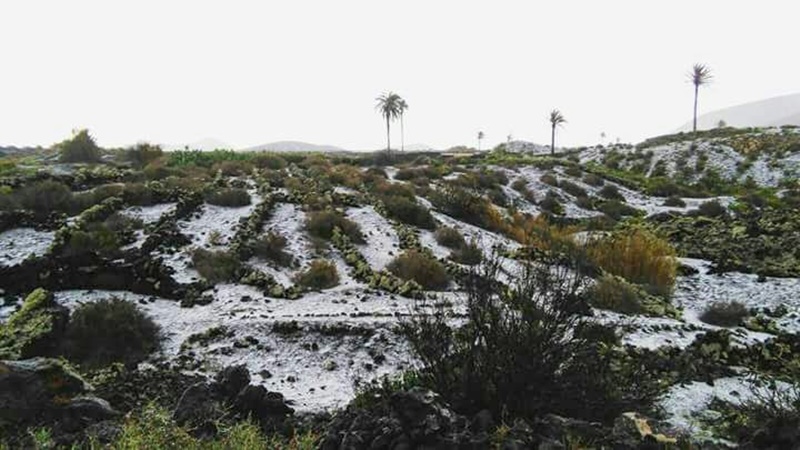
The winter of 2018 has been one of the least warm of the last decades in Lanzarote and summer has taken a long time to arrive
There have been no heat waves in 2018, no hot days, summer clothes are perpetuated in the shop windows, like sandals and air conditioners, beaches are much emptier than in previous years and most of them of Lanzarote people has not come to keep warm clothes for fear of having to take it out at any time. The first five months of this year have been the least warm that are remembered in recent decades and this is corroborated by experts. “In fact, the first five months of the year have been colder than the climatological average of the study period 1980-2010, which is what is established to make the comparisons”, explains Jesús A. Agüera Merino, delegate of the AEMET in Canary Islands.
Change of cycle, punctual?
Agüera assures that everything indicates that this year “will mark a change from a cycle of dry and warm years to a cooler and more humid one, perhaps returning again to cycles of hot, dry years. However, it seems somewhat punctual that does not mark a trend since global warming is undeniable, although the Canary Islands, due to its geographical location and effect of the sea, notice it less. ”
In the specific case of this winter, he points out that “we have attributed the continuous passage of storms to a stratospheric warming and this spring there is a blockade in the area of Scandinavia that directs the storms towards the Peninsula. They are oscillations associated with the annual variability of the climate that is not repeated systematically or periodically. There are no 2 years or equal seasons with the same atmospheric phenomena, “he explains. “In any case in the Canary Islands we are having a very calm spring and without adverse phenomena”.
Global warming, undeniable
For the AEMET delegate in the Canary Islands, “climate change is evident in some areas of the globe but if we understand it as evident changes in weather patterns, rainfall, cold / heat waves or phenomena such as tropical cyclones that previously did not occur in a place and now they are being produced, certainly in the Canary Islands we are not detecting anything that has not been produced before, “he concludes, and explains. “The study of possible climate change in a territory requires decades of study, registration, comparison and analysis of data and in the Canary Islands it is too soon to jump to conclusions”.
It is complicated, in the long term, to know with certainty how the behavior of the climate will be the rest of the summer. “Climate projections are currently being made for long terms and, most reliably, the reports of the Intergovernmental Panel on Climate Change that involve thousands of scientists from all over the world and are being reviewed but it is uncertain to know in a few decades the scenario of emissions of greenhouse gases that we will face, the technologies of generation and use of energy and the policies adopted by decision makers in each country, “he says. “It seems clear a warmer future, an increase in sea level, with more heat waves and droughts and precipitation with greater variability, as well as in certain areas of the world more severe adverse events.”
Contradictions
Agüera explains that the behavior of time in a place “is defined by the geographical situation, the relief, the season of the year, etc., but if the Canary Islands arrive air masses of maritime type coming from cold, even polar areas, and other areas of Europe masses of warm air can produce contradictions like the ones we are experiencing this year: it has been colder, in June, in the Canaries than in some areas of northern Europe. ”
What will happen in our country?
According to the Aemet, in most of the country there are already two phases: a dry one, several years in a row with winters with little rainfall, and a wet phase: one or two years with very rainy winters that alleviate the drought, linked in the last years to the sudden warming of the stratosphere. We are already seeing that the peninsula, in the dry phase is drier and in the wet, much more humid. Experts point out that this may be the Iberian adaptation of the paradigm and society will have to adapt.
How have the first five months of the year been in the Canary Islands?
January
The thermal behavior of January has been cooler than normal in the eastern islands. At the end of the month, the remarkable drop in temperatures produced record temperatures near the ground at the Lanzarote airport weather station: 6.7 ° on the 30th, the second lowest since 2006.
February
February was very cold in most of the territory. The coldest nights took place on days 7, 8 and 14, with minimums below 14 ° in a good part of the coast. The minimum of 7.6 ° on day 7 at Lanzarote airport is the lowest temperature observed there since there are records (1972). It was also the rainiest February since 2010.
March
The temperature anomalies were slight in most of the territory, predominating those with a negative sign.
April
This month it became extremely cold in some areas. No tropical nights were produced in any of the stations, while last year there were. In addition, it was very humid, especially in Lanzarote, arriving to rain up to three times more than expected.
May
May recorded the lowest temperatures since the early 90s. The municipality of Tías stands out, with the lowest temperatures since 1992. None of the stations recorded tropical nights (other years were recorded). The average surface water temperature of the sea (19.3 °) hardly changed with respect to the previous month, being the lowest of the last 10 years.





